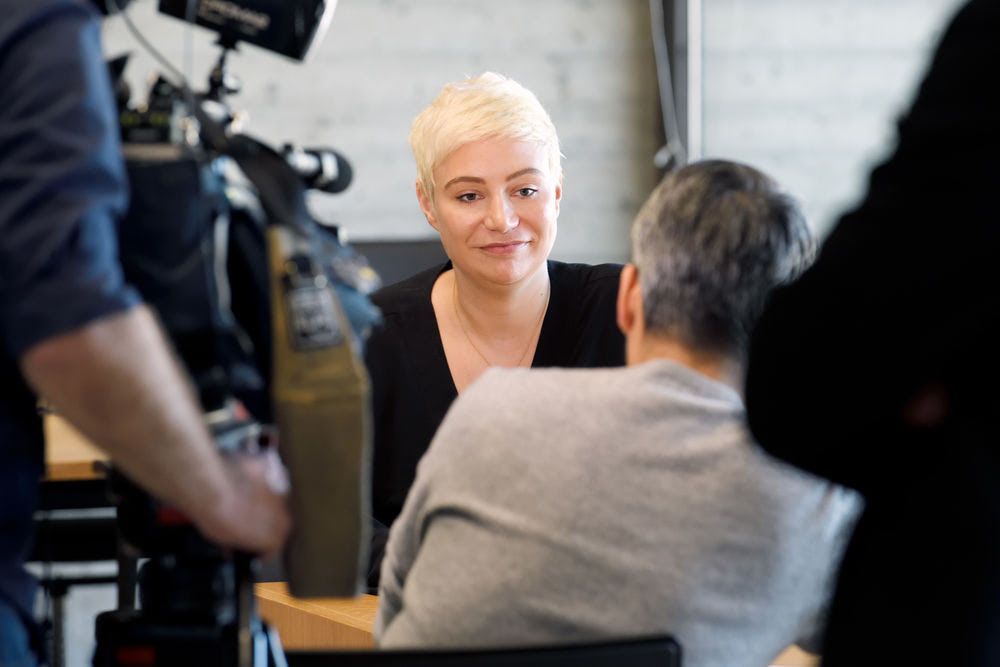“Within a few years it will be possible for a premature baby to continue to mature in an artificial womb,” says gynecologist Guid Oei. It is therefore that the Artificial Womb: Dream or Nightmare? symposium is held on 29 March at the TU/e Center for Humans & Technology—in collaboration with Next Nature Network. Not the question whether it’s possible, but whether we want this or not. Moreover, an ethicist, a journalist and a designer are also invited to share their vision on the artificial womb.
The design
Five large red balloons are hanging from the ceiling in the theatre room. They were designed by Hendrik-Jan Grievink (designer at NNN), in close collaboration with the team of gynecologist Guid Oei from Máxima Medical Centre.
It is not intended for these works of art to cherish the extremely premature babies. Yet, it may seem plausible, as the object is holding connections for the umbilical cord, a supply of simulated amniotic fluid and the electronics that can display the heartbeat and movements of the mother.
But for the time being these bulbs serve as an eye-catcher. “Let the discussion begin,” say Oei and Grievink.
IVF
Journalist Larissa Pans wholeheartedly agrees with them. She wrote the book Unlimited Fertility and speaks about the unforeseen consequences of IVF treatments that have turned the world upside down since the 1970s.
“I consider the current international fertility industry as a spin-off from the discovery of IVF,” she states.

In 1978, the first IVF baby was born in Bristol: Louise Brown. For her book, Pans spoke with gynecologists Bert Alberda and Gerard Zeilmaker, who at the time also tried to allow fertilization outside the body in the Dijkzicht hospital in Rotterdam (NL).
Two years after the birth of Louise Brown, they were allowed to return embryos to the women whose egg cells were fertilized. The first Dutch IVF baby was born in 1983. Now there are eight million IVF babies worldwide.
Tupperware
“Besides a fertility industry, I even see fertility tourism,” says Pans. “Egg-freezing parties are being held in America. There is trade in eggs and sperm, each country has its own rules. Dutch women fly to Cyprus or Spain for an anonymous egg. Is motherhood a right that you can claim?”
The journalist continues to speak about her eye-opening moment. “I understood the feminist view—that it’s a good thing for women to gain power over their fertility. But I once spoke to a woman who was born as a triplet from an anonymous donor. She is angry and feels like a ‘B-child’, because she discovered that she comes from a sperm cocktail from different men. So this means that there are also losers: the children with identity questions.”

Guid Oei is a gynecologist at Máxima Medical Center and saves premature babies. He talks about the problems that prematurely born babies face (the air damages their vesicles) and social concerns (from the huge medical costs to having only fifty percent chance of survival).
It is his dream to be able to use artificial wombs, “not in the lab, but in maternity suites.” Oei expects that it can be that far within a few years. “A lamb has already been born in Japan that grew for weeks in a—transparent—artificial womb.”
Questions, questions, questions
“A lamb in a bag doesn't look like a nightmare, does it,” argues moderator Koert van Mensvoort.
The audience has more questions: Is a child born twice with this technique? And if so, what is the birthday? How does the baby bond with the mother? What does it do with the mother psychologically? Are there any physical consequences? What about milk production? What is the relation to adoption? Oei has no answers yet. “Follow-up is needed,” he says, “but this is a better solution than an incubator.”
Visitor Sylvie Kars takes notes of the questions. She is an educator at Freya, an association for parents with fertility problems. “I find it very interesting to see the possibility of an artificial womb. I was expecting science fiction scenes, but only here do I realize that it can currently be a solution for premature births. That makes it less bizarre. And we have to talk about the possibilities of technology. You can't ignore that.”
Abortion
When Lily Frank from the Philosophy and ethics group (TU / e Faculty of Industrial Engineering & Innovation Sciences) enters the stage, the questions become even more complex. She wonders whether ectogenesis (growing babies outside the womb) will end the abortion discussion.
Other questions follow from her and from the public. Is a fetus entitled to life? Is ending the life of the fetus in the artificial womb the same as abortion? Who decides? The mother, the father, the doctor? Is a fetus the property of parents and do they have the right to destroy it? Does a woman have the right not to become a biological mother?

What started with the future dream of having artificial wombs ends this afternoon with thoughts about contracts for mothers who would rather give up their child in such a womb.
The message is clear, says Van Mensvoort: “Don't be naive about negative side effects. Discuss! And do that beforehand, and not afterwards, as with IVF."
This story is a report from the Artificial Womb: Dream or Nightmare? symposium that took place on March 29th at TU/e. We thank our talented speakers and the wonderfully engaging audience for their contribution. Missed out? Dutch news broadcaster Nieuwsuur was present and filmed a segment of the event. Watch it here (in Dutch).
? Written by Norbine Schalij
? Phototography by Bart van Overbeeke


Comments (0)
Share your thoughts and join the technology debate!
No comments yet
Be the first to share your thoughts!